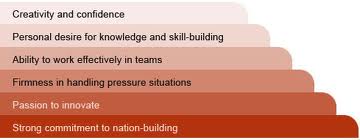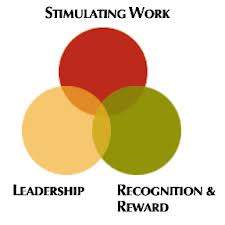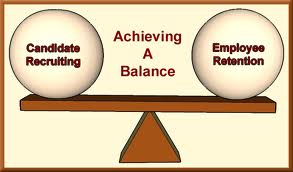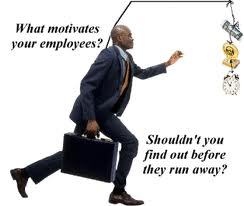Blog Archives
Nice Infographic by Salesforce on Employee Motivation
Posted by Hindol Datta
Posted in Employee Engagement, Employee retention, Extrinsic Rewards, Intrinsic Rewards, Learning Organization, Motivation, Organization Architecture, Recognition, Rewards, Talent Management
Tags: employee engagement, employee recognition, extrinsic motivation, intrinsic motivation, learning organization, organization architecture, rewads, rewards, talent management
Implementing Balanced Scorecard Model for Employee Engagement
Posted by Hindol Datta
The Balanced Scorecard Model (BSC) was introduced by Kaplan & Norton in their book “The Balanced Scorecard” (1996). It is one of the more widely used management tools in large organizations.
One of the major strengths of the BSC model is how the key categories in the BSC model links to corporate missions and objectives. The key categories which are referred to as “perspectives” illustrated in the BSC model are:
Financial Perspective:
Kaplan and Norton do not disregard the traditional need for financial data. Timely and accurate data will always be a priority, and managers will do whatever necessary to provide it. In fact, often there is more than enough handling and processing of financial data. With the implementation of a corporate database, it is hoped that more of the processing can be centralized and automated. But the point is that the current emphasis on financials leads to the “unbalanced” situation with regard to other perspectives. There is perhaps a need to include additional financial-related data, such as risk assessment and cost-benefit data, in this category.
Customer Perspective
Recent management philosophy has shown an increasing realization of the importance of customer focus and customer satisfaction in any business. These are leading indicators: if customers are not satisfied, they will eventually find other suppliers that will meet their needs. Poor performance from this perspective is thus a leading indicator of future decline, even though the current financial picture may look good. In developing metrics for satisfaction, customers should be analyzed in terms of kinds of customers and the kinds of processes for which we are providing a product or service to those customer groups
Internal Business Process Perspective
This perspective refers to internal business processes. Metrics based on this perspective allow the managers to know how well their business is running, and whether its products and services conform to customer requirements (the mission). These metrics have to be carefully designed by those who know these processes most intimately; with our unique missions these are not necessarily something that can be developed by outside consultants. My personal opinion on this matter is that the internal business process perspective is too important and that internal owners or/and teams take ownership of understanding the process.
Learning and Growth Perspective
This perspective includes employee training and corporate cultural attitudes related to both individual and corporate self-improvement. In a knowledge-worker organization, people — the only repository of knowledge — are the main resource. In the current climate of rapid technological change, it is becoming necessary for knowledge workers to be in a continuous learning mode. Metrics can be put into place to guide managers in focusing training funds where they can help the most. In any case, learning and growth constitute the essential foundation for success of any knowledge-worker organization.
Kaplan and Norton emphasize that ‘learning’ is more than ‘training’; it also includes things like mentors and tutors within the organization, as well as that ease of communication among workers, the engagement of the workers, the potential of cross-training that would create pockets of bench strength and switch hitters, and other employee specific programs that allows them to readily get help on a problem when it is needed. It also includes technological tools; what the Baldrige criteria call “high performance work systems.”
Innovation Perspective
This perspective was appended to the above four by Bain and Company. It refers to the vitality of the organization and its culture to provide the appropriate framework to encourage innovation. Organizations have to innovate. Innovation is becoming the key distinctive element in great organizations, and high levels of innovation or innovative thinking are talent magnets.
Taking the perspectives a step further, Kaplan and Cooper instituted measures and targets associated with each of those targets. The measures are geared around what the objective is associated with each of the perspectives rather than a singular granule item. Thus, if the objective is to increase customer retention, an appropriate metric or set of metrics is around how to measure the objective and track success to it than defining a customer.
One of the underlying presumptions in this model is to ensure that the key elements around which objectives are defined are done so at a fairly detailed level and to the extent possible – defined so much so that an item does not have polymorphous connotations. In other words, there is and can be only a single source of truth associated with the key element. That preserves the integrity of the model prior to its application that would lead to the element branching out into a plethora of objectives associated with the element.
Objectives, Measures, Targets and Initiatives
Within each of the Balance Scorecard financial, customer, internal process, learning perspectives and innovation perspectives, the firm must define the following:
Strategic Objectives – what the strategy is to achieve in that perspective
Measures – how progress for that particular objective will be measured
Targets – the target value sought for each measure
Initiatives – what will be done to facilitate the reaching of the target?
As in models and analytics, the information that the model spouts could be rife with a cascade of metrics. Metrics are important but too many metrics associated with the perspectives may diffuse the ultimate end that the perspectives represent.
Hence, one has to exercise restraint and rigor in defining a few key metrics that are most relevant and roll up to corporate objectives. As an example, outlined below are examples of metrics associated with the perspectives:
Financial performance (revenues, earnings, return on capital, cash flow);
Customer value performance (market share, customer satisfaction measures, customer loyalty);
Internal business process performance (productivity rates, quality measures, timeliness);
Employee performance (morale, knowledge, turnover, use of best demonstrated practices);
Innovation performance (percent of revenue from new products, employee suggestions, rate of improvement index);
To construct and implement a Balanced Scorecard, managers should:
- Articulate the business’s vision and strategy;
- Identify the performance categories that best link the business’s vision and strategy to its results (e.g., financial performance, operations, innovation, and employee performance);
- Establish objectives that support the business’s vision and strategy;
- Develop effective measures and meaningful standards, establishing both short-term milestones and long-term targets;
- Ensure company wide acceptance of the measures;
- Create appropriate budgeting, tracking, communication, and reward systems;
- Collect and analyze performance data and compare actual results with desired performance;
- Take action to close unfavorable gaps.
The link above contains a number of templates and examples that you may find helpful.
I have discussed organization architecture and employee engagement in our previous blogs. The BSC is a tool to encourage engagement while ensuring a tight architecture to further organizational goals. You may forget that as an employee, you occupy an important place in the ecosystem; the forgetting does not speak to your disenchantment toward the job, neither to your disinclination toward the uber-goals of the organization. The forgetting really speaks to potentially a lack of credible leadership that has not taken the appropriate efforts to engage the organization by pushing this structure that forces transparency. The BSC is one such articulate model that could be used, even at its crudest form factor, to get employees informed and engaged.
Posted in Business Process, Employee Engagement, Employee retention, Financial Metrics, Financial Process, Innovation, Leadership, Learning Organization, Learning Process, Management Models, Organization Architecture, Recognition, Risk Management, Social Dynamics, Talent Management
Tags: bain and company, balanced scorecard, business process, communication channel, employee engagement, employee recognition, extrinsic motivation, financial process, innovation, intrinsic motivation, learning organization, management tools, mass psychology, model, organization architecture, rewads, risk management, social systems, strategy, talent management, value, value management
Economics of Employee Retention
Posted by Hindol Datta
It is a common fact that employee turnover in a company has significant cost consequences. HR departments and managers deploy programs to create great work environments to prevent employee turnover. Some industries have higher turnover than others. However, despite the expected high turnover rate, companies are realizing that the acquisition cost of getting a new employee to replace someone who has left is meaningfully higher.
There are a number of tangible and intangible costs that have been connected to employee turnover:
- Pre-departure costs—such as the reduced productivity of an employee who is discontented and using company time to look for another job, plus the costs of any efforts to retain the employee once he or she has announced his intent to leave.
- Termination costs—those related to termination of employment, including exit interviews, security precautions, pay calculations, and other recordkeeping costs, plus the unemployment tax impact and payments for severance, accrued vacation time, retirement plan contributions, and any extension to benefits.
- Recruitment costs—related to advertising, recruiting, interviewing, pre-employment evaluations, security and background checks, hiring bonuses, relocation, etc.
- Training costs—the cost of training new employees in necessary job skills can be significant.
- Productivity costs—related to new workers, who are generally less productive, require more supervision, and contribute less to customer satisfaction.
- Vacancy costs—lost sales or lost productivity while the position remains vacant, plus the cost of overtime or temporary help to cover fill in.
- Corporate culture – high turnover is a reflection of corporate culture. If potential candidate become aware of high turnover, this could further increase the corporate’s acquisition costs.
It has been estimated that the cost of employee turnover could range anywhere from 50% of the employee’s salary up to 500% of the employee’s salary.
Employee turnover= (Number of separations per year/ Average number of employees per year)*100
The general median is 130%. Here is a specific scenario to think through:
Assume there are 100 employees in an organization. The average compensation is $50K per year. The employee turnover rate is 10%. That means about 10 employees leave the company in any given year. If the average cost is $50K per year, and the median is 130% or 1.3X compensation cost, then the total impact in this scenario would be $650,000. Thus, it represents almost 13% of the run rate of payroll. If there are programs that could stem the flow out by 50%, that would save $325,000 which represents 6.5% of payroll. This is a fairly significant statistic. And since 130% is a median across all industries, I contend that knowledge industries have a higher median than industries that are driven by low or medium skilled workers at the lower end of the pay scale.
So what are some of the ways that would minimize this turnover? First, whatever the turnover number, the company would want to compare themselves to similar organizations in the specific industry or region. In fact, some turnover may be healthy to the company. Second, one single program may not be good enough. They have to consider multiple programs that could be deployed concurrently or over time.
So, companies seeking a performance-oriented approach to employee retention might seek to enhance work value in some of the following ways (courtesy of the Performance Improvement Council of the Incentive Marketing Association):
Employee involvement in job design, goal setting, and selection of rewards.
Clear communication about company goals and ways employees can contribute to and share in its success.
Incentive programs that reward people for significant and measurable performance improvements.
Recognition programs offering meaningful recognition to employees for both tangible and intangible contributions to their company.
Project-oriented approaches in which all employees can work on diverse, limited-term assignments rather than being sequestered within a single department or function.
Developing talent exchanges to enhance careers by connecting employees with appropriate projects, roles, and positions within their companies.
Training through coordinated programs designed to enhance employee knowledge and then rewarding employees for that increased knowledge. Consider cross training to enhance skills and improve productivity. This both satisfies employees and equips them to perform better.
Fostering feelings of support by setting clear goals for employees and rewarding them upon accomplishment, and by promoting consistent values and recognizing people who embody them. This directs retention resources to actions and values that have a measurable benefit to the organization.
Creating an atmosphere of fun with spot “atta-boy” rewards, contests, or meetings, specifically related to organizational goals and values. This creates an atmosphere conducive to retention while keeping the focus on achieving goals.
Addressing the measurement issue by instituting “real-time” goal setting, performance measurement, and skills development programs to ensure that people always know where they stand, and to address performance issues and skill gaps before they become problems.
Fair Compensation. No one said that compensation will have no effect on turnover and retention. Determine a fair wage in your labor market and do what you can to meet it. A fair and equitable wage and benefits package is the foundation for a successful employee retention program.
Build trust. As mentioned above, a “climate of trust” is one of the factors that influence employee retention. Trust is built with employees through fair working conditions, management responsiveness to employee concerns, realistic performance expectations, and open communication, including one-on-one communications between managers and employees whenever possible.
Don’t limit motivation efforts to star employees. Incentive, reward, and recognition programs should be expanded to include as many employees as possible, rather than just the top 5 or 10 percent. Remember, it is the large middle range of employees that can contribute the most in terms of improved productivity and lower turnover costs.
The Role of Motivation
Higher levels of motivation can translate into a 53 percent reduction in employee turnover, according to a recent study by Stephen Condly, associate professor at the University of Central Florida, Orlando, conducted for the SITE Foundation. No retention strategy can succeed without addressing the issue of employee motivation.
“Incentives, Motivation, and Workplace Performance,” a study conducted by the professors at the University of Southern California for the International Society of Performance Improvement, found the following factors critical to fostering motivation and loyalty.
- Work value. The research confirmed that people stay motivated when they value their work, no matter how mundane the task. Someone building a house for low-income tenants might get pleasure from the most arduous labor, knowing the good that can come from the effort. Organizations can foster work value by recognizing contributions in a meaningful way, and regularly communicating the organizational goals toward which each employee can contribute. They can add to satisfaction through use of incentive programs that set goals for quality or quantity, and reward those who achieve or surpass them.
- Training. Many people draw satisfaction from developing the capability to do their jobs better or acquiring additional skills or responsibility.
- Support. Most people gain satisfaction from knowing that their organization appreciates their effort. This often comes in the form of meaningful recognition to those who achieve their goals or who exemplify important organizational values.
- Emotional appeal. Yes, people work better when they feel happy. Properly structured incentive and recognition programs can foster an atmosphere of fun and excitement, even in dreary jobs.
- Measurement. Knowing how one is doing in the pursuit of a goal is another way to create satisfaction. Effective measures of quality and productivity keep employees focused on goals, especially if accompanied with proper recognition when they succeed.
Posted in Employee Engagement, Employee retention, Extrinsic Rewards, Intrinsic Rewards, Leadership, Learning Organization, Organization Architecture, Recognition, Rewards, Social Dynamics, Talent Management
Tags: employee engagement, employee recognition, employee retention, extrinsic motivation, intrinsic motivation, learning organization, organization architecture, rewads, social systems, talent management, value management
Organization Architecture – Evolving strain!
Posted by Hindol Datta
 Innovation is happening at a rapid pace. An organization is being pummeled with new pieces of information, internally and externally, that is forcing pivots to accommodate changing customer needs and incorporating emerging technologies and solutions. Thus, the traditional organization structures have been fairly internally focused. Ronald Coase in his famous paper The Nature of the Firm (1937) had argued that organizations emerge to arrest transactional costs of managing multiple contracts with multiple service providers; the organization represents an efficient organizational unit given all other possible alternatives to coexist in an industrial ecosystem. Read the rest of this entry →
Innovation is happening at a rapid pace. An organization is being pummeled with new pieces of information, internally and externally, that is forcing pivots to accommodate changing customer needs and incorporating emerging technologies and solutions. Thus, the traditional organization structures have been fairly internally focused. Ronald Coase in his famous paper The Nature of the Firm (1937) had argued that organizations emerge to arrest transactional costs of managing multiple contracts with multiple service providers; the organization represents an efficient organizational unit given all other possible alternatives to coexist in an industrial ecosystem. Read the rest of this entry →








